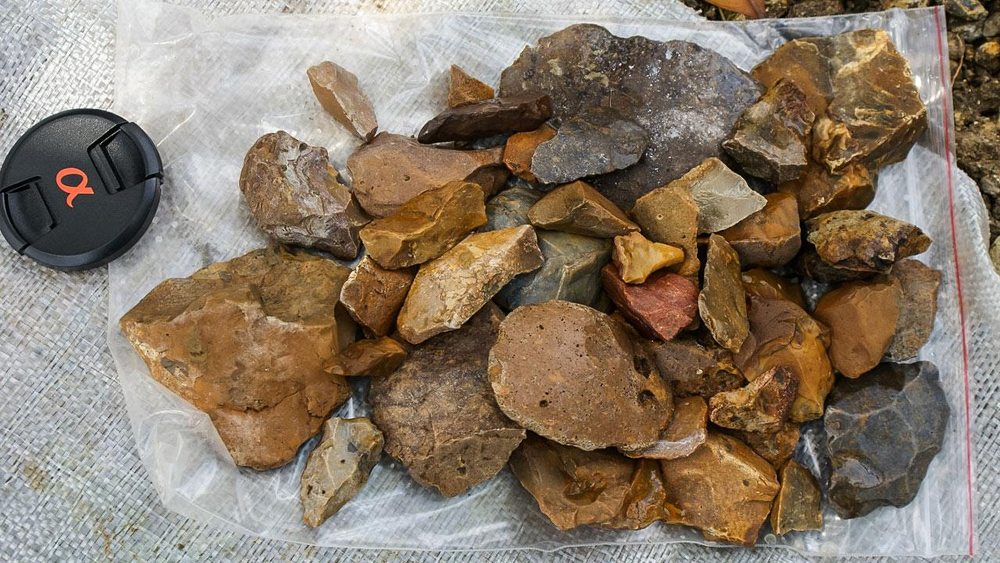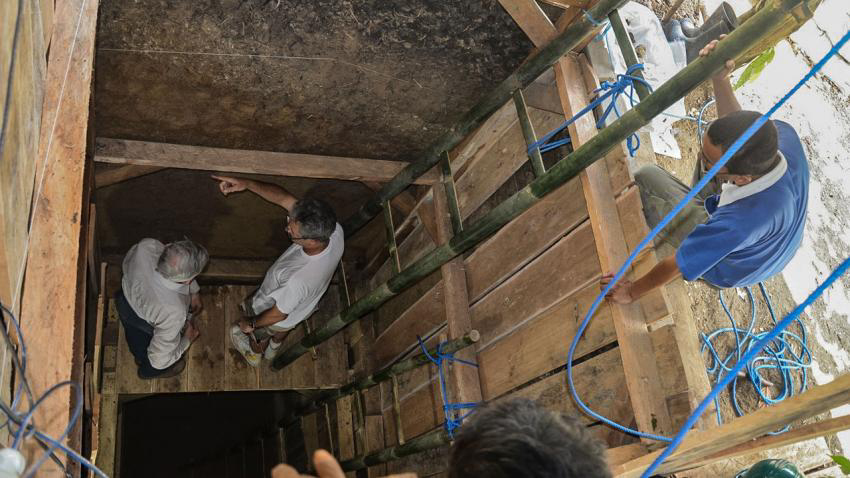


An online article by Elizabeth Culotta on Sciencemag/AAAS - Ancient tools may shed light on the mysterious 'hobbit' - reports on the work by an international team, originally led by the hobbit discoverer, and the discovery of stone tools dated to 118,000 to 194,000 years ago from Sulawesi. These may have been made by another archaic human - or possibly by other 'hobbits'.

Ancient tools from the island of Sulawesi show that human ancestors island-hopped around Southeast Asia, perhaps illuminating the origins of the ancient tiny humans called 'hobbits'. Image: Eric Setiabudi
'The 'hobbit' had neighbours. Back in 2004, researchers announced the discovery of this tiny, ancient human, which apparently hunted dwarf elephants with stone tools on the Indonesian island of Flores 18,000 years ago. Its discoverers called the 1-meter-tall creature Homo floresiensis, but skeptics wondered whether it was just a stunted modern human. In the years since, researchers have debunked many of the 'sick hobbit' hypotheses. Yet scientists have continued to wonder where the species came from.'
The international team reports on another island with evidence of a second archaic early human. This may make the original hobbit claim appear more plausible - human ancestors may have island-hopped.
'After international debate over the hobbit's origins, co-discoverer Michael Morwood - then an archaeologist at the University of Wollongong (UOW) in Australia - set out to search other islands from which the tiny humans may have come. Java, more than 800 kilometers west of Flores but with a chain of islands in between, was already known to be the ancient home of the human ancestor H. erectus, a globe-trotting species that dates as far back as 1.7 million years ago. But Morwood instead set out for Sulawesi, 400 kilometers to the north, because powerful ocean currents sweep southward from this island toward Flores. Researchers had already found some simple stone tools on Sulawesi, but they couldn't date the artifacts because they were found on the ground rather than buried with datable minerals. Morwood assembled a team including paleontologist Gerrit van den Bergh, now of UOW. In 2009 they excavated a promising site, where they found tools down to a depth of about 4 meters. The simple stone flakes and choppers were clearly shaped by humans who knew how to hit rock to produce sharp flakes, says archaeologist and team member Mark Moore of the University of New England in Armidale, Australia. They were probably used to butcher animals such as the pigs and dwarf elephants whose remains were found nearby.'

Archaeologists dug deep in Sulawesi, excavating 10 meters down. Image: Dida Yurnaldi
Using the thermoluminesence dating method, the team dated sediment near some of the tools to 118,000 to 194,000 years ago. Other tools couldn't be dated, but are from deeper layers and so must be older. The oldest H. Floresiensis remains date back to 95,000 years ago, so toolmakers on Sulawesi were striking rocks earlier.
But just who made the tools? The paper lays out the options: very early members of our own species, H. floresiensis itself, H. erectus, or Denisovans.
H.erectus - because remains of that species are found elsewhere in Southeast Asia as recently as 150,000 years ago, this may support a leading theory of the hobbit's origin; that members of H. erectus inhabited Flores and then evolved into a dwarf form, as many other species have done on islands. Stone tools on Flores date back to 1 million years ago, also supporting the idea that H. erectus could have landed on the island early and evolved into the diminutive H. floresiensis over time.
Researchers are now hoping to carry out further excavations on Sulawesi and other islands.
Read more about Homo floresiensis:
http://www.bradshawfoundation.com/origins/homo_floresiensis.php
by Bradshaw Foundation
Tuesday 21 March 2023
by Bradshaw Foundation
Tuesday 07 February 2023
by Bradshaw Foundation
Thursday 19 May 2022
by Bradshaw Foundation
Tuesday 19 October 2021
by Bradshaw Foundation
Friday 25 June 2021
by Bradshaw Foundation
Monday 09 November 2020
by Bradshaw Foundation
Tuesday 03 November 2020
by Bradshaw Foundation
Wednesday 28 October 2020
by Bradshaw Foundation
Tuesday 23 June 2020
by Bradshaw Foundation
Thursday 04 June 2020
by Bradshaw Foundation
Thursday 14 May 2020
by Bradshaw Foundation
Tuesday 12 May 2020
by Bradshaw Foundation
Wednesday 19 February 2020
by Bradshaw Foundation
Tuesday 21 January 2020
by Bradshaw Foundation
Monday 20 January 2020
by Bradshaw Foundation
Thursday 28 November 2019
by Bradshaw Foundation
Tuesday 21 March 2023
by Bradshaw Foundation
Tuesday 07 February 2023
by Bradshaw Foundation
Thursday 19 May 2022
by Bradshaw Foundation
Tuesday 19 October 2021
by Bradshaw Foundation
Friday 25 June 2021
by Bradshaw Foundation
Monday 09 November 2020
by Bradshaw Foundation
Tuesday 03 November 2020
by Bradshaw Foundation
Wednesday 28 October 2020
by Bradshaw Foundation
Tuesday 23 June 2020
by Bradshaw Foundation
Thursday 04 June 2020
by Bradshaw Foundation
Thursday 14 May 2020
by Bradshaw Foundation
Tuesday 12 May 2020
by Bradshaw Foundation
Wednesday 19 February 2020
by Bradshaw Foundation
Tuesday 21 January 2020
by Bradshaw Foundation
Monday 20 January 2020
by Bradshaw Foundation
Thursday 28 November 2019
Friend of the Foundation











